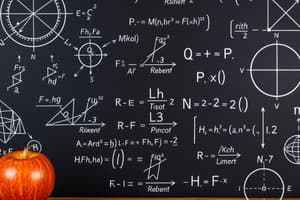Podcast
Questions and Answers
Which branch of mathematics focuses on the relationships between angles and sides of triangles?
Which branch of mathematics focuses on the relationships between angles and sides of triangles?
- Geometry
- Trigonometry (correct)
- Algebra
- Calculus
What does the order of operations BODMAS stand for?
What does the order of operations BODMAS stand for?
- Brackets, Orders, Division, Multiplication, Addition, Summation
- Brackets, Operations, Division, Multiplication, Addition, Subtraction
- Brackets, Orders, Division, Multiplication, Addition, Subtraction (correct)
- Brackets, Other, Division, Multiplication, Addition, Subtraction
Which of the following is NOT a type of number?
Which of the following is NOT a type of number?
- Irrational Numbers
- Natural Numbers
- Whole Numbers
- Finite Numbers (correct)
According to the Fundamental Theorem of Arithmetic, how can integers greater than 1 be expressed?
According to the Fundamental Theorem of Arithmetic, how can integers greater than 1 be expressed?
Which mathematical field involves the study of change and motion?
Which mathematical field involves the study of change and motion?
In the context of mathematics, which of these pairs is correctly matched?
In the context of mathematics, which of these pairs is correctly matched?
Which formula is used to find the hypotenuse in a right triangle?
Which formula is used to find the hypotenuse in a right triangle?
Which type of number includes only fractions where both the numerator and denominator are integers?
Which type of number includes only fractions where both the numerator and denominator are integers?
Flashcards are hidden until you start studying
Study Notes
Overview of Mathematics
- Definition: Mathematics is the study of numbers, quantities, shapes, and patterns using symbols and rules.
- Branches:
- Arithmetic: Basic operations (addition, subtraction, multiplication, division).
- Algebra: Use of symbols and letters to represent numbers and express mathematical relationships.
- Geometry: Study of shapes, sizes, and properties of space.
- Trigonometry: Focus on the relationships between angles and sides of triangles.
- Calculus: Study of change and motion, involving derivatives and integrals.
- Statistics: Collection, analysis, interpretation, presentation, and organization of data.
Fundamental Concepts
- Numbers:
- Natural Numbers: Counting numbers (1, 2, 3,...).
- Whole Numbers: Natural numbers plus zero (0, 1, 2, 3,...).
- Integers: Whole numbers and their negatives (..., -2, -1, 0, 1, 2,...).
- Rational Numbers: Fractions where both numerator and denominator are integers.
- Irrational Numbers: Numbers that cannot be expressed as fractions (e.g., √2, π).
- Real Numbers: All rational and irrational numbers.
Mathematical Operations
- Basic Operations:
- Addition (+)
- Subtraction (−)
- Multiplication (×)
- Division (÷)
- Order of Operations: BODMAS/BIDMAS (Brackets, Orders (i.e. powers and square roots, etc.), Division/Multiplication, Addition/Subtraction).
Key Theorems and Principles
- Pythagorean Theorem: In a right triangle, a² + b² = c², where c is the hypotenuse.
- Fundamental Theorem of Arithmetic: Every integer greater than 1 can be uniquely factored into prime numbers.
- Quadratic Formula: For ax² + bx + c = 0, x = [−b ± √(b² - 4ac)] / (2a).
Applications of Mathematics
- Science: Mathematical modeling and data analysis.
- Engineering: Design, analysis, and problem-solving.
- Economics: Statistical analysis, optimization.
- Computer Science: Algorithms, data structures, cryptography.
- Finance: Interest calculations, risk assessment.
Study Tips
- Practice Regularly: Solve problems daily to reinforce concepts.
- Understand Concepts: Focus on understanding rather than memorization.
- Use Visuals: Diagrams and graphs can aid comprehension, especially in geometry and calculus.
- Group Study: Discussing topics with peers can enhance understanding.
- Utilize Resources: Online tutorials, textbooks, and math software can aid learning.
Overview of Mathematics
- Mathematics studies numbers, quantities, shapes, and patterns through symbols and rules.
- Major branches include:
- Arithmetic: Encompasses basic operations like addition, subtraction, multiplication, and division.
- Algebra: Utilizes symbols to represent numbers and express relationships.
- Geometry: Analyzes shapes, sizes, and spatial properties.
- Trigonometry: Investigates relationships between angles and sides in triangles.
- Calculus: Examines change and motion, focusing on derivatives and integrals.
- Statistics: Involves gathering, analyzing, and presenting data.
Fundamental Concepts
- Natural Numbers: Counting numbers starting from 1 (1, 2, 3,...).
- Whole Numbers: Natural numbers including zero (0, 1, 2, 3,...).
- Integers: Whole numbers along with their negatives (..., -2, -1, 0, 1, 2,...).
- Rational Numbers: Fractions where both the numerator and denominator are integers.
- Irrational Numbers: Numbers that cannot be expressed as fractions, e.g., √2, π.
- Real Numbers: All encompassing rational and irrational numbers.
Mathematical Operations
- Core operations include addition (+), subtraction (−), multiplication (×), and division (÷).
- The order of operations is guided by BODMAS/BIDMAS: Brackets, Orders (including powers and roots), Division/Multiplication, Addition/Subtraction.
Key Theorems and Principles
- Pythagorean Theorem: In a right triangle, the relationship a² + b² = c² holds, with c representing the hypotenuse.
- Fundamental Theorem of Arithmetic: Every integer greater than 1 can be uniquely expressed as a product of prime numbers.
- Quadratic Formula: Solves ax² + bx + c = 0, given by x = [−b ± √(b² - 4ac)] / (2a).
Applications of Mathematics
- Science: Employed in mathematical modeling and statistical data analysis.
- Engineering: Utilized for design, analytical problem-solving, and technical calculations.
- Economics: Involves statistical analysis and optimization techniques.
- Computer Science: Critical for algorithms, data structuring, and cryptography.
- Finance: Used in calculating interest and assessing financial risks.
Study Tips
- Practice Regularly: Consistent problem solving enhances concept retention.
- Understand Concepts: Emphasize comprehension over rote memorization for deeper learning.
- Use Visuals: Diagrams and graphs assist in understanding complex topics, especially in geometry and calculus.
- Group Study: Collaborative learning with peers can improve understanding and retention of material.
- Utilize Resources: Take advantage of online tutorials, textbooks, and math software for further support and learning.
Studying That Suits You
Use AI to generate personalized quizzes and flashcards to suit your learning preferences.




